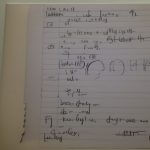Study Habits: Do You Have A Ritual?

Aaron is a PhD student. This requires him to spend a significant fraction of his time thinking about hard things.
To accommodate the necessity of depth in his working life, Aaron developed a ritual he uses to quickly shift his brain into a state of concentration.
Here’s how it works:
Aaron puts on headphones and plays non-distracting meditative music (this track is a favorite).
He launches FocusWriter, a stripped-down text editor that hides all the features of your computer (not unlike George R. R. Martin’s use of Word Star).
He loads up a template that contains seven questions about the deep task he’s about to begin.
These questions force him to specify why the task is important and how he’s going to tackle it (see the above screenshot of the template taken from one of Aaron’s work sessions). The issues addressed in this template come from a classic Steve Pavlina post titled “7 Ways to Maximize Your Creative Output.”
Getting through these steps takes around five minutes. As soon as Aaron’s done typing in his final answer he turns immediately to the scheduled deep task.
This is such a great idea for anyone who’s ever had trouble getting started, and it makes us think about our own techniques for getting into a deeper state of efficacy. To find one’s way in focusing on deeper tasks, we recommend the following:
Limit Distractions.
In keeping with Aaron’s technique, it’s good to have a ritual that allows you to reset your brain and guide it toward the task at hand. With smartphones going off every five minutes, this is easier said than done, but it’s essential to the effort. Some suggestions that I do: place smartphone on airplane mode, leave it in the car or another room, and minimize access to the Internet. As noted above, that may involve using a stripped down word processor that cuts you off from easy accessibility. What I do: when I really need to focus on the work at hand, I switch to my iPad/Keyboard combo. This way I don’t limit my ability to type, but I do make the Internet more of an inconvenience. It’s a heck of a lot easier Command [or Alt]+Tab-ing to another window than it is to double-click the Home button on the iPad and sift through my open apps to Safari. Oh sure, it may only take a couple of seconds longer, but it requires me to move my hands from the keyboard every time I want to switch back. The inconvenience ensures that I don’t get sidetracked from the program I’m in and the task I’m working on.
Clear Your Mind.
Aaron (not his real name by the way) uses a meditative piece of music to focus his mind. I use silence and meditation. Just what do I think about while meditating? Well, I break down the essential tasks that I HAVE to accomplish if I’m going to deem the day a success. If that means writing five articles, I’ll try to do nothing during my moment of silence but go over each assignment in my head and form a quick plan of attack for each. I’ll make sure a timer is set for no more than 20 minutes while I accomplish this task. That way, the “ticking clock” aspect forces me to focus quickly and not waste any time thinking of titles and approaches. If there is any time left on the timer — and there usually is — I’ll use it to try and relax my mind completely. Once the timer goes off, I grab my notebook or iPad and go to work.
Dig Deeper.
Aaron in the example above uses 7 questions about the task at hand. Why seven? Again, he takes it from the article by Pavlina. For sake of expediency, we urge you to give Pavlina’s original article a read-through here. Aaron just makes questions out of each of Pavlina’s points and goes through answering each one. You don’t have to do this, and that’s fine if you choose not to as long as you’re thinking about questions that will need to be answered by your study and research. Personally, if I’m doing an article, then I will try to come up with three to five subheads (and more if the piece is supposed to be longer). The point is to break down the task at hand as much as you possibly can so you don’t feel the rush to accomplish everything at once. That’s also why I recommend giving yourself ample time to study if you’re going to take an exam. After all, the further you go in your education, the more difficult tests and professional exams will be. Cramming is less and less of an option when difficult concepts are at the heart of what you’re doing. By drilling down deep on the subject at hand, you essentially build a detailed battle plan to help you stay on course.
In Summary
The point of this post, and the original Cal Newport blog on which Aaron’s technique first appeared, isn’t to give you a cookie-cutter approach for tackling problems. It is to teach you that you NEED an approach — a ritual, if you will — before ever cutting to the heart of the matter. While you can learn a lot about ritual/approach from other people, only you are equipped to know what works best for you, and that requires patience, time, and commitment to finding a way. Experiment as much as you can, and soon you’ll be accomplishing more than you ever thought possible.
What are some of the deeper study habits and rituals that you employ to get your study sessions off the ground? Share what works for you in our comments section! And if you’ve yet to develop a technique, feel free to steal liberally from some of our suggestions.








